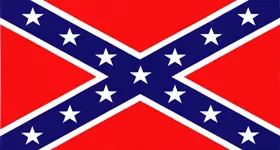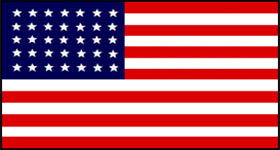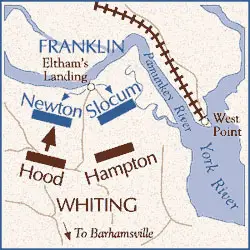 
| |||||||||||||||||||||
|
While the Battle of Williamsburg was raging around Fort Magruder on May 5th, Gen. George B. McClellan was asking for reinforcements, and Brig. Gen. Franklin’s division (part of McDowell’s Corps which had been detached from the Army of the Potomac) was returned to him. Shortly after arriving at Fort Monroe, McClellan had them back on their transports to move up to West Point, the eastern end of the Richmond & York River Railroad. This amphibious strike force was sent up the York River to cut off the Confederate retreat toward Richmond.
The Confederate retreat up the Virginia peninsula from Yorktown began on the 3rd. The Union Army of the Potomic pursued, and a vicious rearguard engagement occured on the 5th at Williamsburg. Franklin landed his troops at Eltham’s Landing on the 6th. Franklin's movement occurred while the Confederate army was withdrawing from the Williamsburg line. The plan was to get behind Gen. Joseph E. Johnston and attack his wagon trains as they withdrew. Johnston ordered a resumption of the withdrawal on the 6th, except for Maj. Gen. Gustavus W. Smith's wing covering the army's flank along the York River. Concerned about the army's wagon train, Johnston kept Smith's experienced soldiers at Barhamsville, a spot particularly vulnerable to a Union attack from the River.
 |
Smith waited throughout the morning of the 6th while the wagons rumbled past and the army's rear divisions closed. In the afternoon, Smith learned that Union transports, protected by gunboats, had arrived at the head of the river at Eltham's Landing. Union soldiers soon disembarked, forming a line on the south bank opposite Smith's flank. Johnston reacted swiftly to the news, redirecting the other units of the army toward Smith. By the morning of the 7th, the entire Confederate army was concentrated at Barhamsville.
Smith didn't contest the Union landing on the 6th, hoping to lure the Union troops inland beyond the range of the gunboats' heavy ordnance. But on the morning of the 7th, when the Federals remained behind their works, Smith decided to attack. He ordered Brig. General W. H. C. Whiting's division forward to clear the woods and to advance feild artillery for a bombardment of the landing and the transports.
Whiting's brigades drove into the woods, pushing back the Union skirmishers 1.5 miles. When Confederate artillerists argued that the transports were beyond their range, and with the Union infantry sheltered by a bluff, Whiting abandoned the attack.
This minor engagement lasted only 2 hours. Whiting's advance secured the Confederate flank, permitting the uneventful passage of the wagon train.
The Battle at Eltham's Landing was little more than a heavy skirmish. There were 194 Union casualties and 48 Confederate. Franklin told McClellan, "I congratulate myself that we have maintained our position." Although the action was tactically inconclusive, Franklin missed an opportunity to intercept the Confederate retreat from Williamsburg, allowing it to pass unmolested.
Johnston was pleased with the outcome. Considering the success his men enjoyed in executing the order "to feel the enemy gently and fall back," he humorously asked General Hood, "What would your Texans have done, sir, if I had ordered them to charge and drive back the enemy?" Hood replied, "I suppose, General, they would have driven them into the river, and tried to swim out and capture the gunboats."
